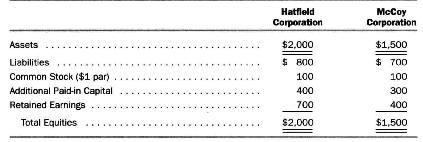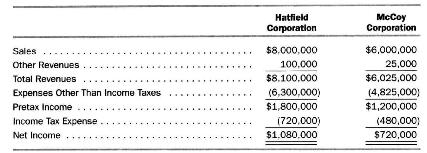Effect of purchase and pooling-of-interests methods on financial statements. (Requires coverage of Appendices 11.1 and 11.2.) Hatfield
Question:
Effect of purchase and pooling-of-interests methods on financial statements. (Requires coverage of Appendices 11.1 and 11.2.) Hatfield Corporation and McCoy Corporation agree to merge on January 1, Year 8, when the balance sheets of the two companies appear as follows (amounts in thousands):

Hatfield issues 50,000 shares of its common stock with a market value of \(\$ 1,400,000\) to the owners of McCoy in return for their 100,000 shares of McCoy Corporation common stock. The recorded assets of McCoy Corporation have a market value in excess of book value of \(\$ 400,000\).
a. Prepare a consolidated balance sheet for Hatfield Corporation and McCoy Corporation on January 1, Year 8, using the purchase method.
b. Projected partial income statements for Hatfield Corporation and McCoy Corporation for Year 8 before considering the effects of the merger appear below.

Make the following assumptions:
(1) The income tax rate for the consolidated firm is 40 percent.
(2) Where necessary, Hatfield Corporation amortizes the extra asset costs over five years in the consolidated statements.
(3) In calculations for tax returns, Hatfield Corporation cannot deduct, from taxable income, amortization of asset costs arising from the purchase.
(4) McCoy Corporation declared no dividends.
Prepare a consolidated income statement for the first year following the merger.
Step by Step Answer:

Financial Accounting An Introduction To Concepts Methods And Uses
ISBN: 9780324183511
10th Edition
Authors: Clyde P. Stickney, Roman L. Weil





